In July of 2011 Mia and I visited perhaps our favorite place in the universe – Red Rock Lakes National Wildlife refuge in the Centennial Valley of Montana. This trip was memorable for a variety of reasons, including a hailstorm that literally “rocked” our world and that of the birds around us.
I used these images in a similar post about 5 years ago but since most current readers have never seen them I reworked the post for this presentation.
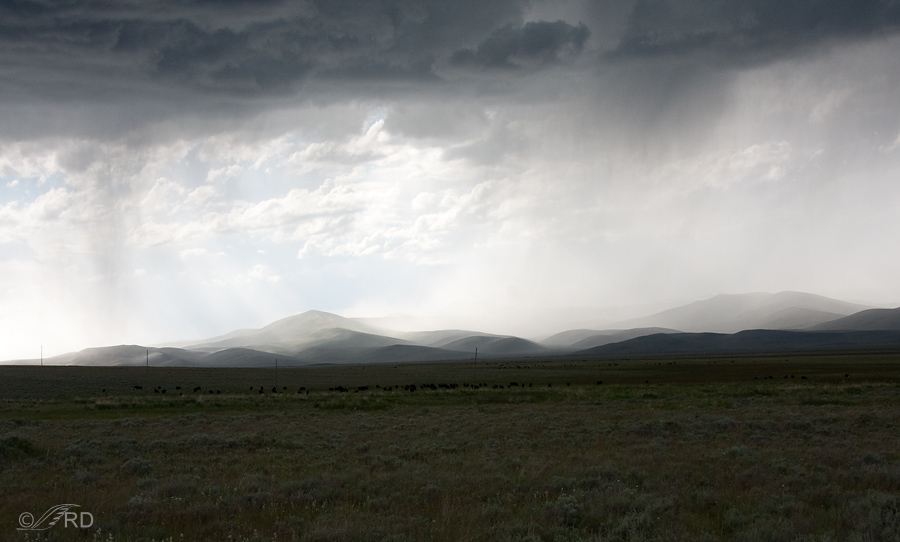
5:30 pm. We were photographing American Avocets and Wilson’s Phalaropes on one of the refuge ponds when we looked behind us to the west and saw an impressive storm building and beginning to head our way. It was really dumping on the foothills surrounding the valley and we figured things might get interesting so we decided to stay at the pond and see what happened.
It was a good thing we were shooting from my pickup and not on foot or we’d have been in trouble…
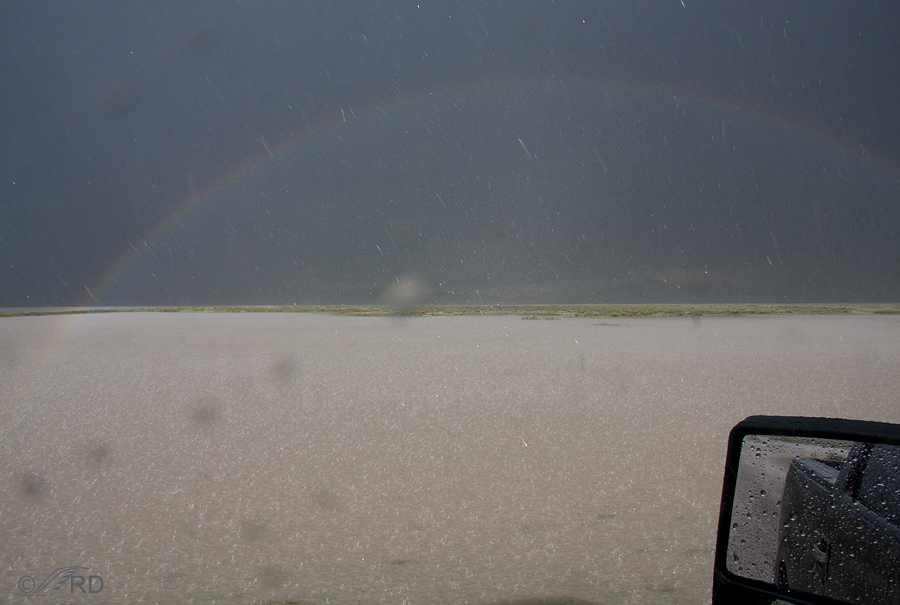 5:52 pm. The slow-moving storm took a while to get to us but when it did it was impressive. It began to rain very hard which turned the pond into a frothing, foamy mess. It was so intense that neither of us could keep water off of our lenses while they protruded from the windows – in spite of the 7″ long hood on the end of my 500mm lens. We were shooting from my new Ford F-150 pickup but the engineers did a poor job on the roof rain channels and water simply poured inside off the roof whenever a window was down.
5:52 pm. The slow-moving storm took a while to get to us but when it did it was impressive. It began to rain very hard which turned the pond into a frothing, foamy mess. It was so intense that neither of us could keep water off of our lenses while they protruded from the windows – in spite of the 7″ long hood on the end of my 500mm lens. We were shooting from my new Ford F-150 pickup but the engineers did a poor job on the roof rain channels and water simply poured inside off the roof whenever a window was down.
As you can see in my side mirror, Mia (who shoots from the back seat) has taken a temporary respite from the downpour and has her lens pulled in and her window up.
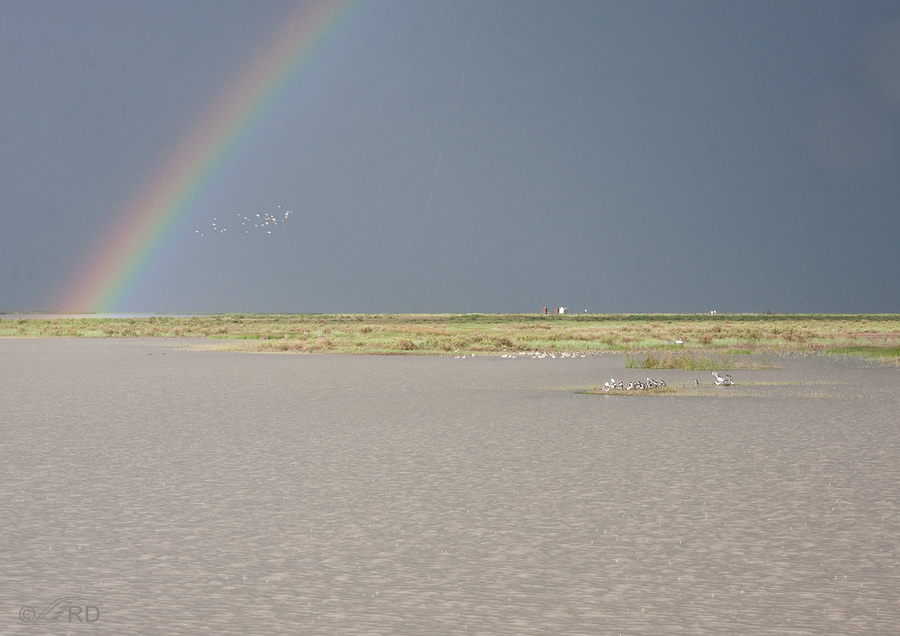 6:15 pm. A temporary reprieve from the rain – with rainbow and light. But it was literally the calm before the (real) storm – a sucker hole. You can see my camping trailer (plus two outhouses) on the horizon.
6:15 pm. A temporary reprieve from the rain – with rainbow and light. But it was literally the calm before the (real) storm – a sucker hole. You can see my camping trailer (plus two outhouses) on the horizon.
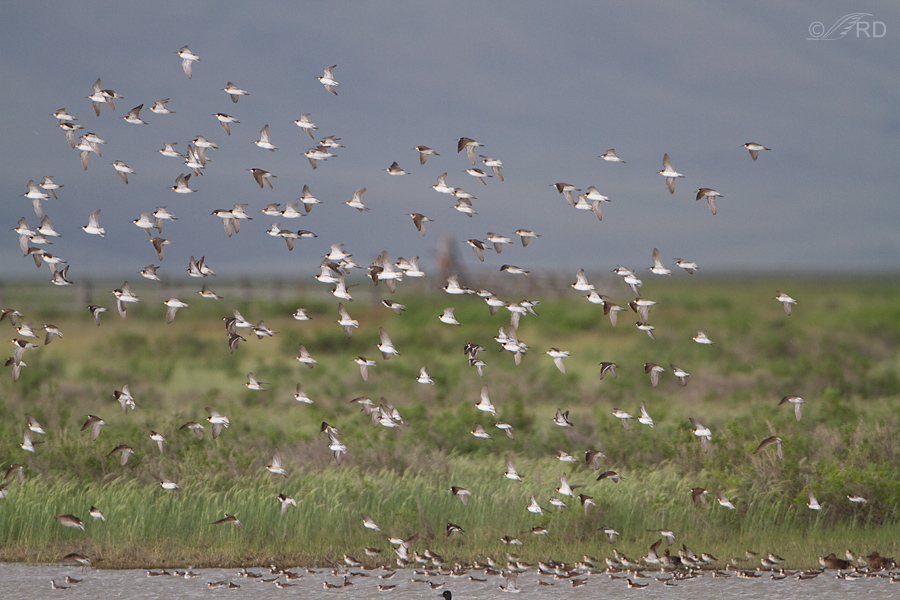 6:31 pm. As the most intense part of the storm approached the birds reacted by bunching up in flocks of their own species and flying nervously around the pond.
6:31 pm. As the most intense part of the storm approached the birds reacted by bunching up in flocks of their own species and flying nervously around the pond.
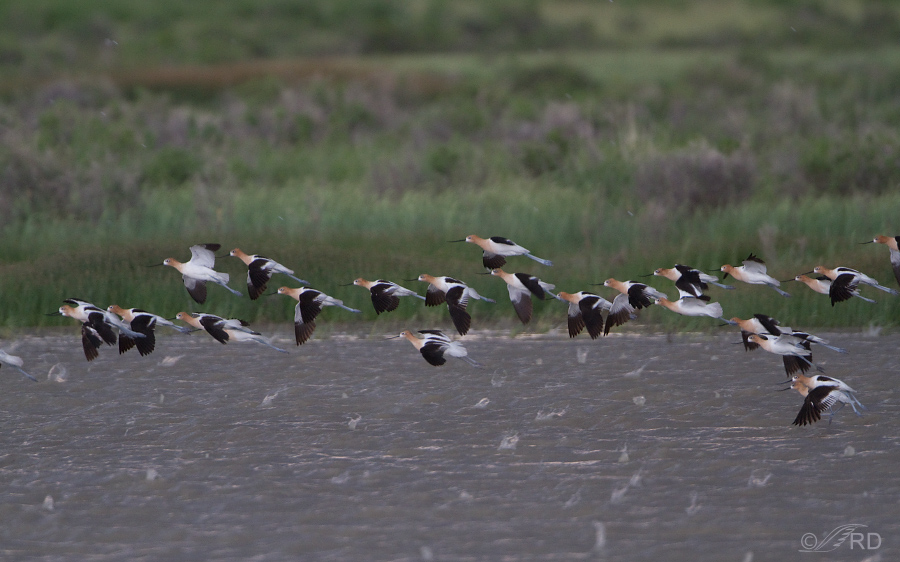 6:32 pm. As the hail began it became quite dark. Here you can see it impacting the water and if you look closely you can see that it is coming in at a slant from left to right causing the impact plumes on the water surface to splash to the right. Later the direction of the hail would change.
6:32 pm. As the hail began it became quite dark. Here you can see it impacting the water and if you look closely you can see that it is coming in at a slant from left to right causing the impact plumes on the water surface to splash to the right. Later the direction of the hail would change.
Occasionally I could see a hailstone striking a bird, even in flight.
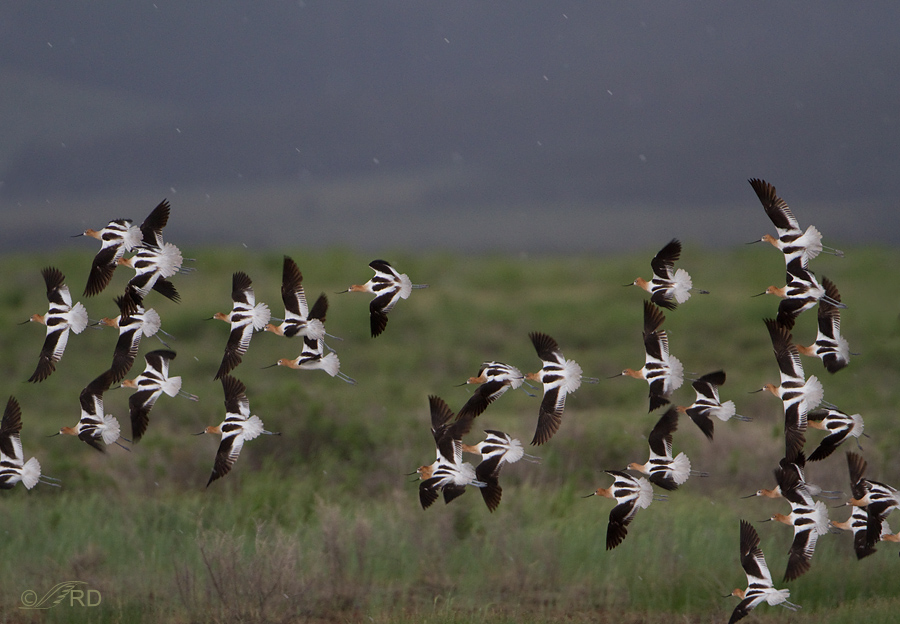 6:33 pm. The behavior of the birds seemed to indicate that they didn’t know what to do to escape the hail. They flew circular patterns in these tight flocks for a while but soon changed tactics.
6:33 pm. The behavior of the birds seemed to indicate that they didn’t know what to do to escape the hail. They flew circular patterns in these tight flocks for a while but soon changed tactics.
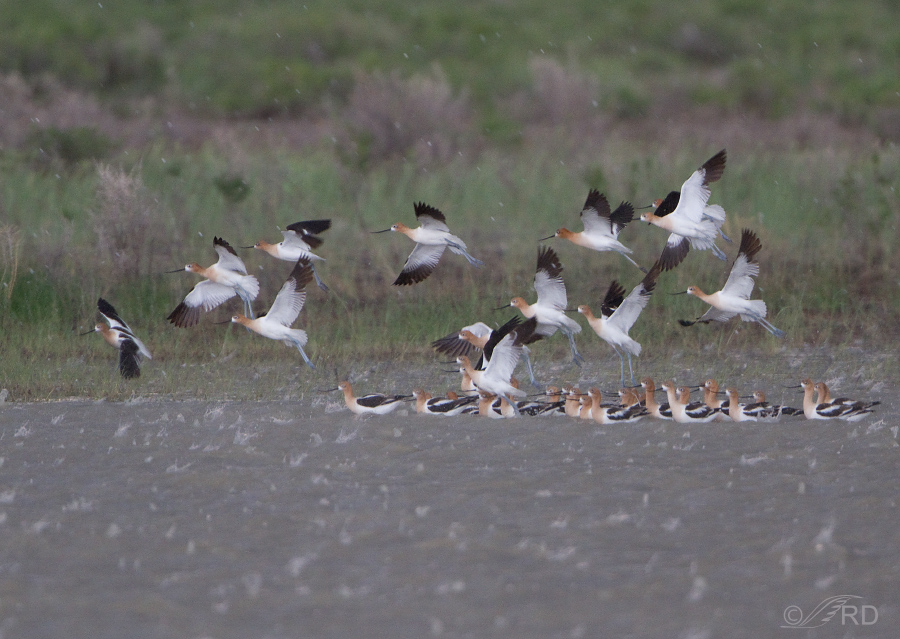 6:33 pm. As the hail continued to intensify most of the avocets settled into the water while others simply raised their wings, floated up in the wind and hovered over their companions. They were really being pummelled by the hail and seemed very confused and frightened.
6:33 pm. As the hail continued to intensify most of the avocets settled into the water while others simply raised their wings, floated up in the wind and hovered over their companions. They were really being pummelled by the hail and seemed very confused and frightened.
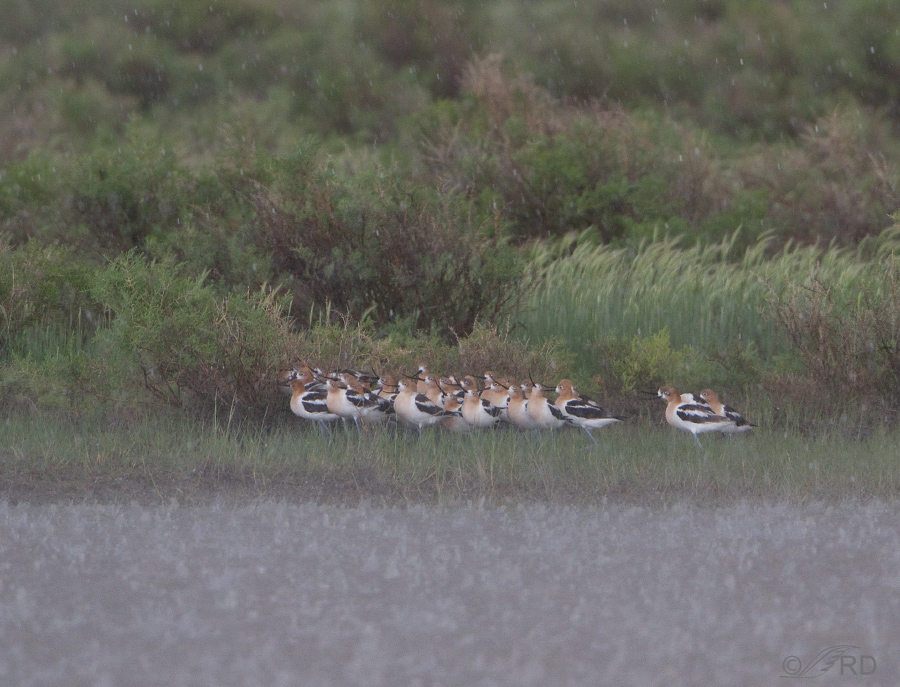 6:35 pm. Within a couple of minutes they walked from the water to the shore and bunched up tightly against each other and against the background brush. Apparently avocets were just too large to huddle under most of the plants along the shore but that’s exactly what most of the smaller phalaropes did. There are phalaropes crouching out of sight in the brush behind the avocets.
6:35 pm. Within a couple of minutes they walked from the water to the shore and bunched up tightly against each other and against the background brush. Apparently avocets were just too large to huddle under most of the plants along the shore but that’s exactly what most of the smaller phalaropes did. There are phalaropes crouching out of sight in the brush behind the avocets.
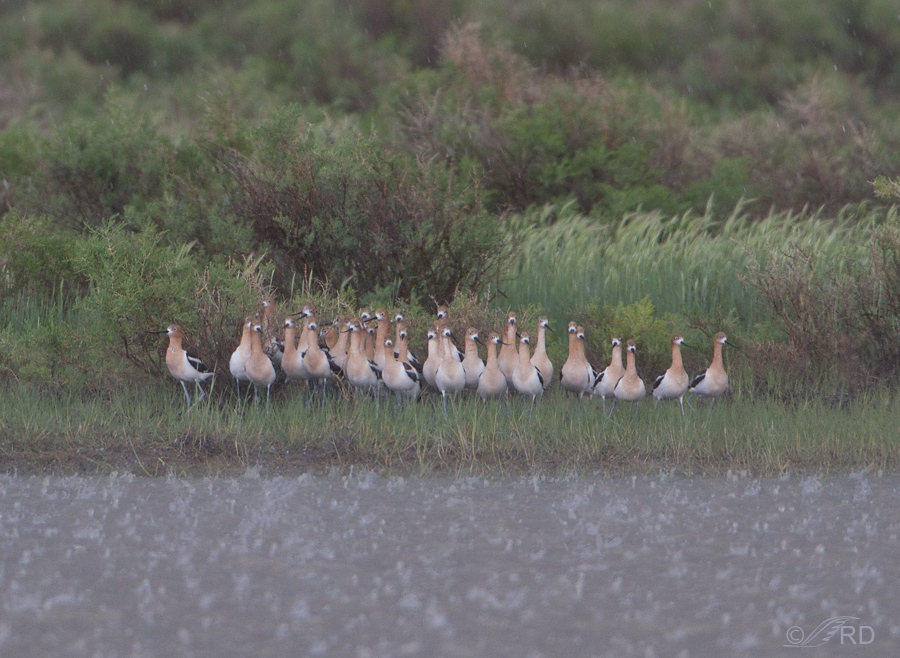 6:35 pm. Within seconds most of the hail abated and the intensity of the rain increased. The avocets reacted immediately by beginning to tentatively walk back toward the water.
6:35 pm. Within seconds most of the hail abated and the intensity of the rain increased. The avocets reacted immediately by beginning to tentatively walk back toward the water.
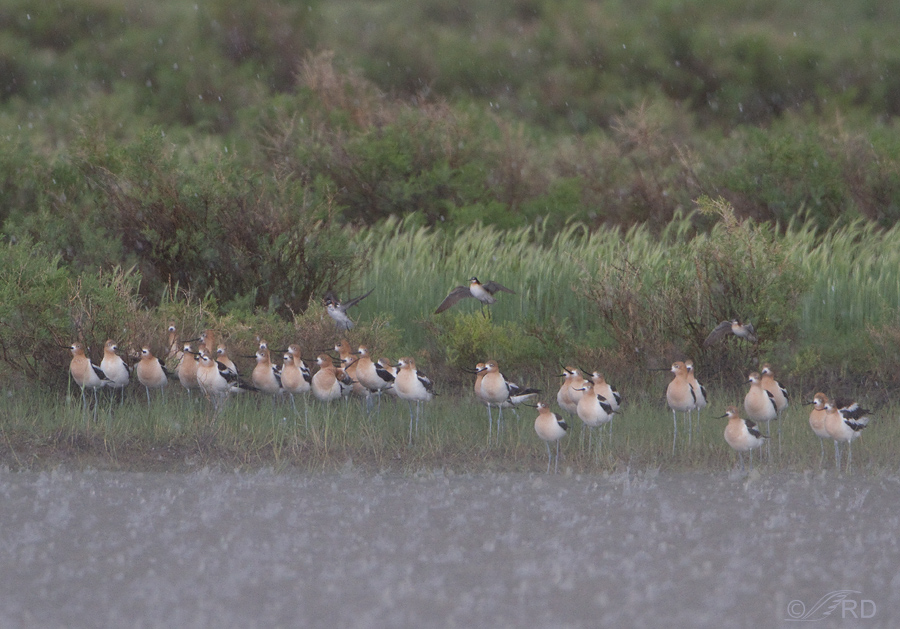 6:35 pm. The phalaropes reacted to the hail stoppage almost as quickly as the avocets did. Here you can see three of them emerging from the background brush and hovering over the avocets.
6:35 pm. The phalaropes reacted to the hail stoppage almost as quickly as the avocets did. Here you can see three of them emerging from the background brush and hovering over the avocets.
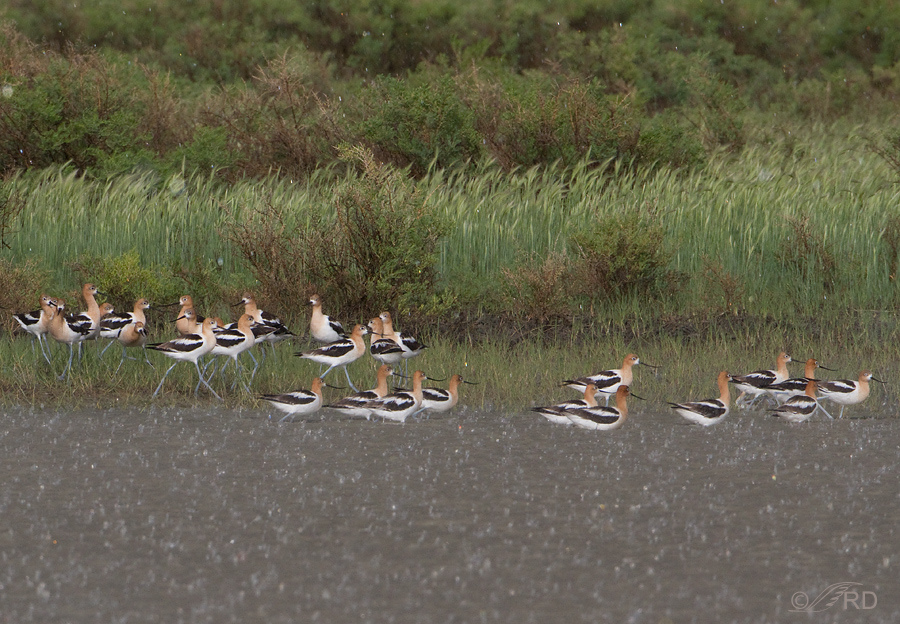 6:37 pm. Even though it was still raining hard the avocets seemed almost jaunty in having survived the hail.
6:37 pm. Even though it was still raining hard the avocets seemed almost jaunty in having survived the hail.
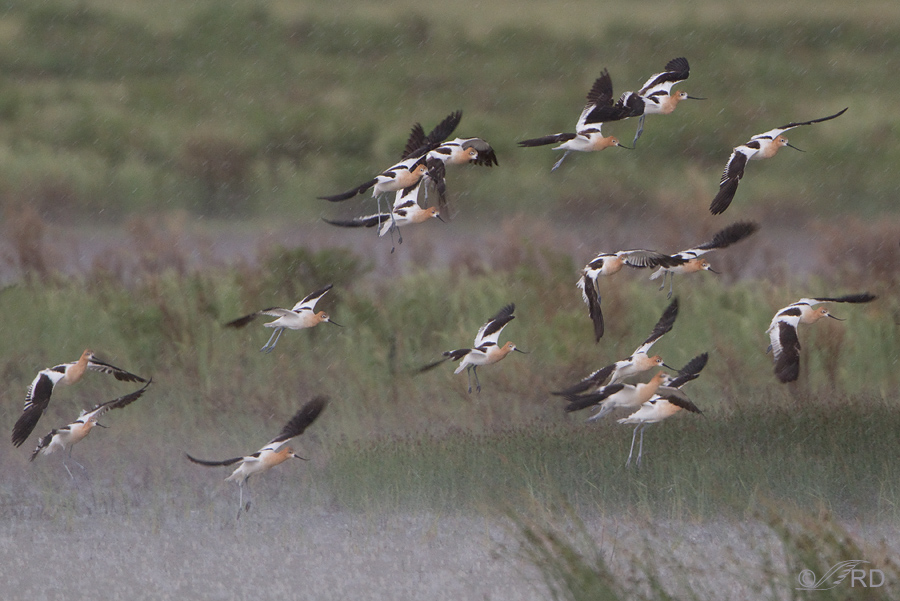 6:48 pm. At times the rain would intensify again but the birds seemed to do fine with it, flying in small groups in tight little circles and then landing again – seemingly in celebration of having survived the hail. Notice in the upper background that the direction of slant of the raindrops has now changed from some of my earlier images in this post.
6:48 pm. At times the rain would intensify again but the birds seemed to do fine with it, flying in small groups in tight little circles and then landing again – seemingly in celebration of having survived the hail. Notice in the upper background that the direction of slant of the raindrops has now changed from some of my earlier images in this post.
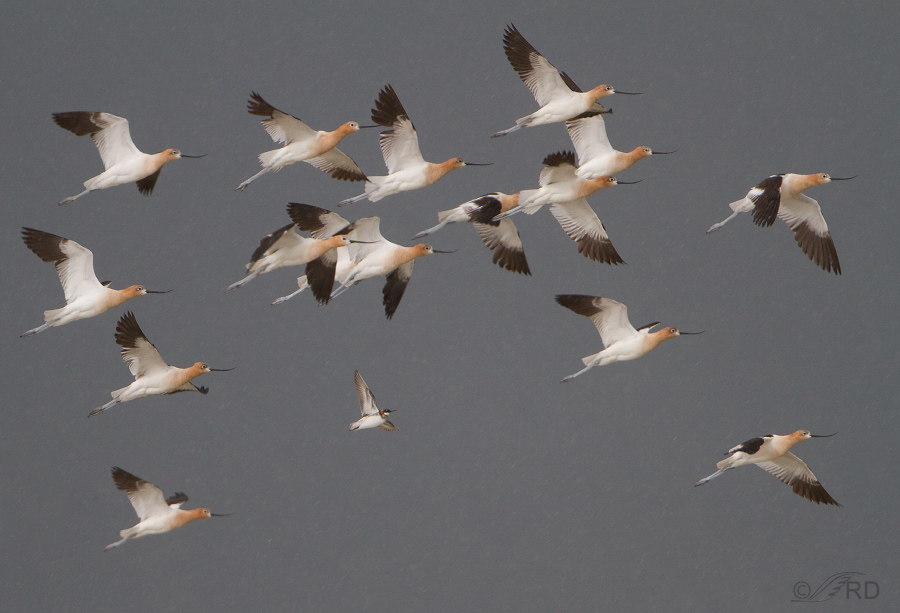 6:57 pm. These “celebratory” flights provided some nice opportunities for photos of the birds in flight against the threatening dark skies in the background. I liked this image of the avocets with a single phalarope amongst them in a formation that seemed almost protective of the phalarope. The background “noise” in this image is really rain.
6:57 pm. These “celebratory” flights provided some nice opportunities for photos of the birds in flight against the threatening dark skies in the background. I liked this image of the avocets with a single phalarope amongst them in a formation that seemed almost protective of the phalarope. The background “noise” in this image is really rain.
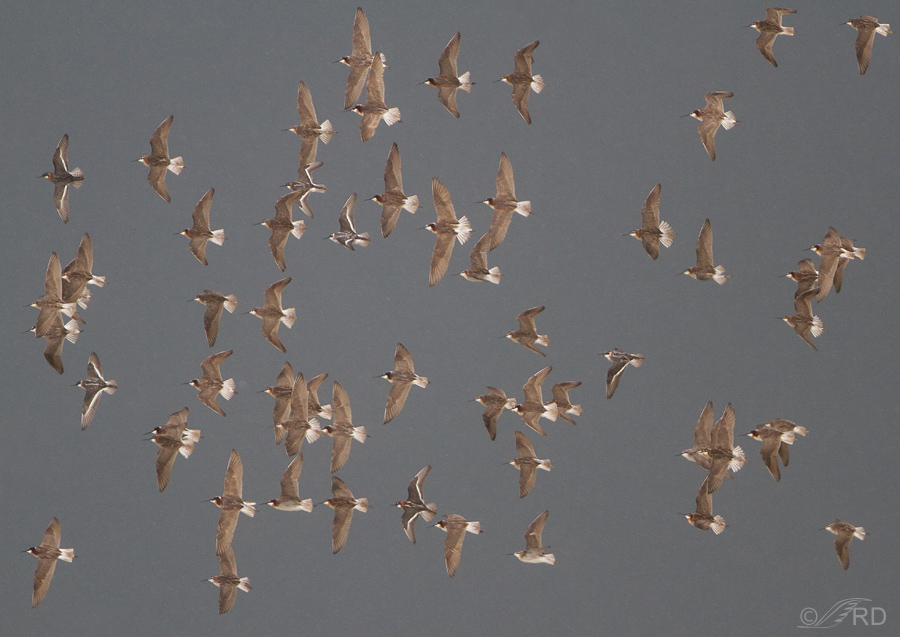 7:01 pm. The phalaropes also joined in these flights. Most of these birds are Wilson’s Phalaropes but a sharp-eyed observer will notice that at least 6 of them are Red-necked Phalaropes (slightly smaller with white markings on the rear surface of their upper wings).
7:01 pm. The phalaropes also joined in these flights. Most of these birds are Wilson’s Phalaropes but a sharp-eyed observer will notice that at least 6 of them are Red-necked Phalaropes (slightly smaller with white markings on the rear surface of their upper wings).
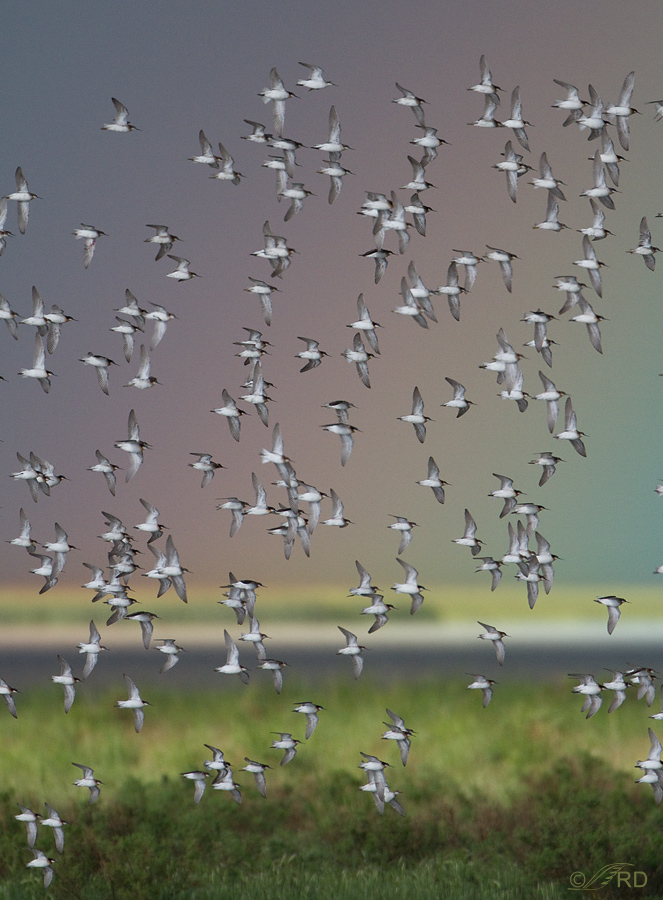
7:06 pm. And then to top it all off, as the storm dissipated a glorious rainbow appeared to provide background color for some more flight shots of the phalaropes.
What an experience this was for Mia and I and for the birds I’m sure. It impressed on me once again just how vulnerable birds are to so many different kinds of events – both natural and man-caused. If these hailstones had been much larger I’m sure that birds would have been injured or killed. Maybe some were and I just didn’t notice it.
Even I felt a bit intimidated by the hail and I was inside my pickup. I can only imagine how frightening it must have been for the birds.
Ron
General camera techs – The first 3 images in this post were taken with a Canon 40D and standard lens. The rest of them were taken with a Canon 7D and my older 500 f/4 lens at ISO 800 and shutter speeds as low as 1/500 second even for some of the birds in flight. Aperture was 5.6. Conditions were challenging to say the least.


This is an incredible behavioral series with several ‘art prints’ in the mix. Fascinating read and top-notch photography, Ron!
Thanks so much for sharing them.
Your bravery (with a new truck,no less)was certainly rewarded with some outstanding shots! Thanks for sharing!
Charlotte
My dogs, goats and I were “trapped” inside a corrugated-tin barn during a sudden golf-ball-sized hailstorm in Colorado. You want to talk about a DIN! It was like all of the assembled drumline corps at a competition were banging on the building – roof and all four walls! The critters and I were happy to be safe from the pounding, even though it was deafening where we were. The cows and horses were in another shelter barn, and the chickens had scurried into whatever shelter they could find.
I wonder if the park service – or citizens – would ever consider erecting long, low shelters with peak roofs, along the waterways or wherever, for various birds or critters to shelter under during such storms? Would they learn to use them, as domesticated animals do?
Great pictures and thanks for reposting them! Your website looks great – I’ll have to spend some time here!
.
Given that I have seen hail shatter windows I am not surprised that it ‘bothered’ the birds. Their bones are so fragile, and there is just no escape from storms of that type.
So glad that it appears that battered and bruised was the extent of the damage. This time.
Another amazing series.
It must have been so exhilerating to be there. A tad freaky, but exciting just the same.
W.W.W
Fantastic images, but I don’t envy you being in the Centennial during a hail storm! However, with the big sky and wide view, it is impressive to watch storms roll in around here. Do you know if the snow is gone from Centennial yet? Thanks for reposting some of your earlier shots. I lve it
“I don’t envy you being in the Centennial during a hail storm”
Actually, I wouldn’t have missed it for the world, Jane.
No, I haven’t heard if the snow in the valley is gone yet. It’s getting close to the time I should be investigating though…
Absolutely fascinating! I love this kind of stuff. I do feel sorry for the birds but looks like they came out okay.
I think they did come out “okay” this time, Marya. It was sure touch and go for a while though.
What a simply spectacular series of shots, Ron. And insert the standing repetitively redundant OH WOW here!
Several years ago, one of those monster hail storms with baseball-sized hail hit west Texas and decimated a family group of wild Harris’ hawks during nesting season. That’s all I know of since it was reported by the falconers in the area who were closely monitoring those nests, but I’d guess many nests of various species were decimated as well. So very sad. At least these guys were mobile and could defend themselves as best they could. And not matter what its size, it hurts when hail hits you!
Laura, I’d guess that hailstorms are one of several reasons that many birds choose to nest under the leaves of trees. I can hardly imagine what it would be like for species that nest out in the open.
Yes, it can be hideous. And my guess is you’re right about nesting with the protection of leaves.
That said, when the really big storms hit in Texas, you’d see lots of badly dimpled cars…imagine…shudder!
Beautiful pictures. I could feel the hail as I scrolled through the pictures. Very intense!!!
Since I’m not a birder, meaning I love looking at them but don’t know their names, I’m going to google phalarope for the pronunciation.
Intense it was, Carol – even inside my pickup.
Ron:
Thank you! Wonderful story for you to share, and great photographs. Avocets are such beautiful birds! They look even more glorious against that dark sky. Wow!
I’m glad you enjoyed them, Richard. Thank you.
Very interesting series…love the sky-wide rainbow in the last frame…have never seen any thing Ike it. When you’ve seen the damage hail can do to the top, hood, fenders and other parts of a vehicle, you cringe thinking what it can do to something as fragile as a bird….
Patty, I can’t imagine being a bird in storms like this. It must be absolutely terrifying for them.
WOW, really interesting patterns on the birds. I have never even seen pics of these birds before. Still so much to see in this country before I pass on.
Ron, thanks as always for sharing
Well, don’t “pass on” anytime soon, David – give yourself time to see’em all!
Great images with glorious light and a story to boot! I too felt like I was with you and Mia! I have witnessed baseball size hail in KY and it was quite impressive. Actually dented cars!
Nancy, Mia once had pretty severe damage to her vehicle from hail too. Thankfully it’s never happened to me but it’s been close a time or two.
Two species I’m not familiar with so this was a lot of fun for me. I love the “retro” posts!
“I love the “retro” posts”
Glad to hear that, Arwen. I’ll probably continue to do them occasionally but promise to not overdo it.
Wow! Fantastic images! Avocets and phalaropes–two of my favorite names for birds. Thank you for re-posting this event. I almost felt like I was experiencing it all first hand. I “survived” grape sized hail during a storm in Central Oregon once, but luckily I too, was sheltered in my vehicle and not exposed like these poor birds were.
Thanks very much, Mark.
Gorgeous! Mother nature sure can put on a show and scare the hell out of everyone/everything! Had golf ball sized hail here a couple of years ago that made the water on Belt Creek dance with plumes 3 to 4′ tall! Everything got out of the way! The avocets certainly beautiful birds. Thx for reposting this! 🙂
The noise inside my pickup from the hail was deafening, Judy. And intimidating. I can’t imagine what it would have been like if the hail had been the size of golf balls.
Boy, do these shots bring back memories! When we camped across country we spent a few days in North Dakota and birded several areas around Lostwood. There used to be and hopefully still is a large nesting colony of Avocets there. What a sight, took some nice 35mm slides of that area – you could get quite close while they were nesting since the road was right beside the nesting colony.
At least you had some cover, we almost got caught on this trip while staying at Lostwood in a developing Tornado that we could see developing above us, but it touched down in Minot.
Wonderful shots and many thanks for sharing.
Thanks, Dick. Intense storms, no matter the kind, really get your attention, don’t they? Especially when you’re “out there” in it!